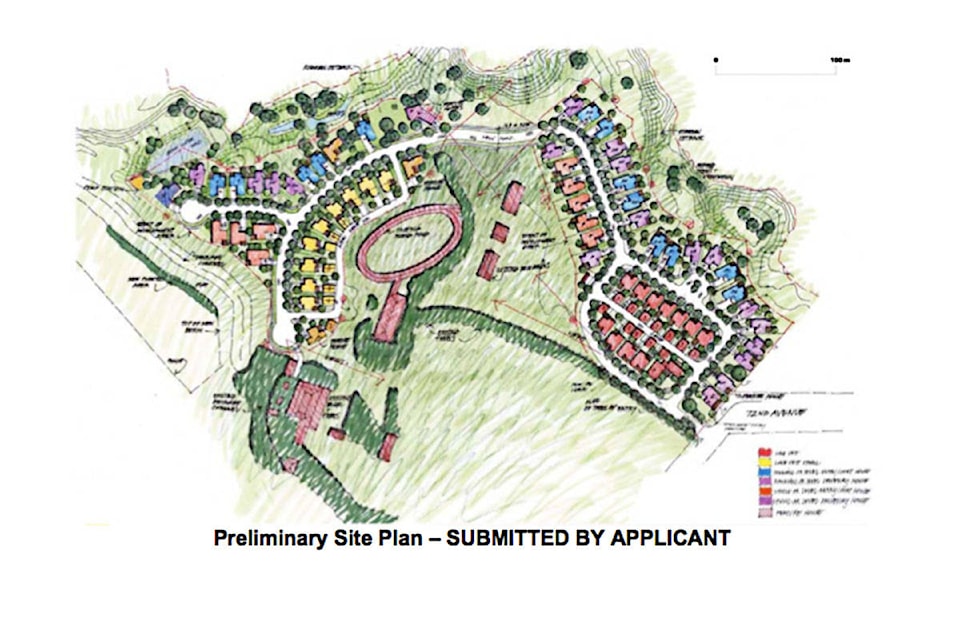A controversial development planned near Trinity Western University remains in limbo due to delayed highway upgrade plans.
“We don’t know exactly how to resolve it,” said Ramin Seifi, manager of development and engineering for Langley Township.
The issue is a single clause in plans by the Wall Financial Corporation to develop 67 lots on a large plot of farmland near 72nd Avenue and Springbrook Road.
In 2014, Township council voted to allow the project. Of the 153 acre site, 13.5 acres was to be developed into housing, with 52 acres of the site closest to the Salmon River becoming Township property for conservation purposes. The rest was to remain farmland.
Access to the lots was to be off 72nd Avenue, plus an emergency access onto the Springbrook Road portion of Highway 10.
Before development began, the owners had to create some “minor improvements at the Highway 10/72 Avenue intersection,” according to a 2014 Township report.
Those minor improvements have now become tied up into debates about widening the Trans Canada Highway.
Seifi noted that parts of Highway 10 – a provincial road – were in need of safety upgrades even before the rezoning, and the province has made some changes there over the past few years.
But the provincial government identified the offramp from the Trans Canada Highway and its connection to Highway 10 as an issue.
“What has to happen is, there has to be a different offramp configuration,” Seifi said.
Rather than just rebuilding one offramp, provincial authorities began looking at rebuilding the entire, aging cloverleaf structure.
That project was then folded into larger plans to widen the Trans Canada as far east as Abbotsford.
But with a new NDP government in office, it’s not clear if the highway will be widened that far east.
A spokesperson for the Ministry of Transportation and Infrastructure noted that the highway is being widened to six lanes as far east as 216th Street, where a new interchange is under construction.
“At this time, provincial funding has not been committed to any additional projects, nor are there any cost-sharing arrangements in place with other levels of government,” the statement said. “Any future projects on Highway One will be announced at a future date.”
It has been nearly four years since the project was approved.
If it never goes ahead, one of the development’s foes on council would be fine with that outcome.
“I hope they never do it,” said Councillor David Davis, who has a family farm in the area. “It should never have a subdivision on it, as far as I was concerned.”
Attempts to contact the Wall Financial Corporation about the site were unsuccessful.
The history of the development goes back to 2002, when Wall Financial Corporation first asked the Agricultural Land Commission to allow non-farm use on the property.
After the initial request for a 65-lot subdivision and equestrian centre was turned down by the ALC, Wall tried again in 2007 with a modified proposal.
This time they won approval subject to a number of conditions, including completion of the work by 2012.
By 2012, the plans were still moving forward, but the Township had become embroiled in a dispute with Metro Vancouver.
The Wall property was lumped in with plans by Trinity Western University to expand and create a “university district.” Metro Vancouver opposed those plans and the Wall development and eventually that led to Metro and the Township squaring off in court.
By March of 2014, the Township had won its court case as the B.C. Supreme Court ruled it had authority over development decisions.
Throughout the entire process, local environmentalists and farmland advocates opposed the Wall subdivision. They worried about the loss of farmland, impacts on the nearby Salmon River, and about a precedent for “spot zoning.” Spot zoning is creating subdivisions that are disconnected from larger neighbourhoods, and which have little access to amenities such as shops and transit lines.
